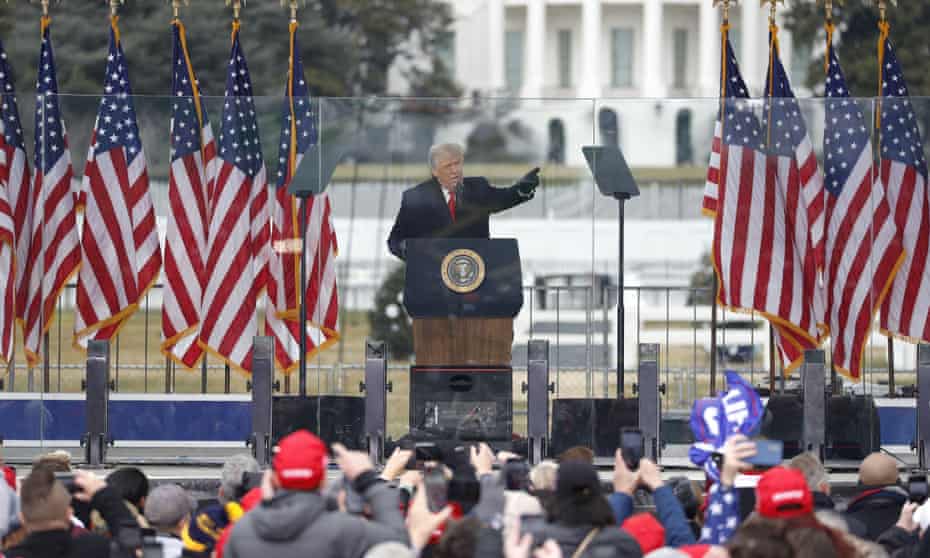The former president used donations to a nonexistent legal defense fund for his hotels and the January 6 Ellipse rally

At 8.38pm on 4 November 2021, the day after America had gone to the polls to elect its next president, Donald Trump sent out a message to hundreds of thousands of his supporters from the email
By then it was already clear that not only was victory eluding Trump, but that he was heading towards defeat. A couple of hours earlier, Associated Press had called Michigan and Wisconsin for Joe Biden, putting the Democratic candidate just six electoral college votes away from the White House.
Friend,” it began. “The Democrats are trying to STEAL the Election. I’ve activated the Official Election Defense Fund and I need EVERY PATRIOT, including YOU, to step up and make sure we have enough resources to PROTECT THE INTEGRITY OF OUR ELECTION.”
Over the next nine weeks Trump bombarded his loyal followers with a blitzkrieg of emails, sometimes 25 in a single day. Some of the emails were specific, like the one sent on 8 November calling for help in Michigan where Trump said “we have filed a lawsuit to halt counting” (the email didn’t say that a judge had already thrown out the complaint as baseless).
Some of the emails were general, pleading with Trump supporters to “defend our democracy” and prevent the “Radical Left” from “DESTROYING America”. They were sent under several different names – from Trump himself, his sons Don Jr and Eric, the former speaker of the House of Representatives Newt Gingrich, the current chair of the Republican National Committee Ronna McDaniel, and then vice-president Mike Pence.
Despite the nuances, all the millions of emails sent out from the @victory.donaldtrump.com address essentially said the same thing. They exhorted Trump supporters to back the “Official Election Defense Fund” with their hard-earned dollars.
“If EVERY Patriot chips in $5, President Trump will have what it takes to DEFEND the Election and WIN!” said the email that was transmitted on 10 November – three days after Biden’s victory had been sealed.
There was only one problem with this epic flurry of emails: the Official Election Defense Fund did not exist. As the House committee investigating the January 6 insurrection at the US Capitol revealed in a public hearing this week, Trump and his allies raised $250m from the emails by persuading loyal followers to donate to a chimera.
There was no fund dedicated to fighting election battles as part of Trump’s mendacious and ultimately vain “big lie” that the presidency had been stolen from him. Instead, the money went into Trump’s new fundraising entity Save America Pac, from where millions of dollars were distributed to pro-Trump organizations including his own hotel properties and the company that produced the Ellipse rally in Washington on January 6 just hours before the storming of the Capitol.
As Zoe Lofgren, a Democratic member of the January 6 committee, put it: “The big lie was also a big rip off.”
David Becker, executive director of the non-partisan Center for Election Innovation and Research, said that the nonexistent “election defense fund” added a new layer to the January 6 investigation. On top of insurrection, sedition and an attempted coup, the American people were now learning about grift.
“We now know that Donald Trump was told repeatedly by his own family, cabinet and staff that his claims about a stolen election had no merit, and yet he continued to use those claims to raise money,” Becker said.
“He was selling false claims to his supporters. The money they gave was not even being used for what he said it would be used: fighting the election in court.”
Lofgren’s unveiling of “the big rip-off” is not the first time Trump has been accused of playing rough and loose when it comes to cash. In his book Uncovering Trump, the former Washington Post journalist David Fahrenthold lays bare the sleight of hand the real estate developer practiced in his charitable dealings dating back to the 1980s.
During his first presidential run in 2016, Trump said he had given away “tens of millions” in charitable donations over his lifetime. Yet when Fahrenthold went looking for evidence of such benevolence, all he could find were records of $6m having been transferred to Trump’s charitable arm, the Trump Foundation, since 1987.
It was also unclear where most of that $6m had gone. The only hard evidence of philanthropic giving amounted to a few thousand dollars.
One such gift, for $20,000, turned out to have been used by Trump to buy a portrait of himself to give to his wife Melania.
Fahrenthold’s reporting at the Post uncovered other irregularities. Trump used more than a quarter of a million dollars from his charitable foundation to cover legal fees incurred in lawsuits relating to his profitable businesses.
The largest gift from the foundation, of $264,631, was used to repair a fountain on the grounds of the New York Plaza hotel, which Trump owned at the time.
If Trump’s claims about his philanthropic largesse raised questions, so too did his use of taxpayers’ money during his time in the White House. While in the presidency, he billed government departments for millions of dollars for use of his Mar-a-Lago club in Florida and other hotel properties.
Trump has also come to the rescue of those who have been accused of defrauding unsuspecting conservative Americans by making false promises to them. Steve Bannon, the former White House chief strategist, w
Not that you would have known it from Trump’s email.
Gavin Rawson, 35, died trying to rescue Nathan Walker, 19, at the site of food waste company Greenfeeds Limited in Leicestershire, in December 2016.
Mr Rawson's family demanded to know why the company had been allowed to continue operating, following a previous death at the site in 2005.
The Health and Safety Executive (HSE) said firms needed to be responsible.
 IMAGE SOURCE,LEICESTERSHIRE POLICE
IMAGE SOURCE,LEICESTERSHIRE POLICEA Woodstock man on Friday denied a dozen crimes stemming from a March police chase and serious crash.
Ethan J. Rioux-Poulios, 26, appeared by videoconference in Oxford County Superior Court from Oxford County Jail, where he pleaded not guilty to nine felony-level charges and three misdemeanor-level charges.
The polls were closed in Iowa for less than 48 hours when South Carolina Sen. Tim Scott was shaking hands and posing for pictures with eastern Iowa Republicans at a Cedar Rapids country club last week.
Scott, one of the many Republicans testing their presidential ambitions, hardly has the state to himself.
At least a half-dozen GOP presidential prospects are planning Iowa visits this summer, forays that are advertised as promoting candidates and the state Republican organization ahead of the fall midterm elections. But in reality, the trips are about building relationships and learning the political geography in the state scheduled to launch the campaign for the party’s 2024 nomination.
While potential presidential candidates have dipped into Iowa for more than a year, the next round of visits marks a new phase of the ritual. With Iowa’s June 7 primary out of the way, Republicans eyeing the White House can step up their travel and not worry about stepping into the state’s intraparty rivalries.
Each of the felony-level aggravated assault charges carries a maximum penalty of 30 years in prison.
He's charged with three counts of reckless conduct with a dangerous weapon, eluding an officer, driving to endanger, leaving the scene of an accident involving serious bodily injury or death. Each of those is punishable by up to five years in prison.
Hopwood DePree found a 60-room English manor.
As a child growing up in Holland, Mich., in the 1970s, Mr. DePree was transfixed when his beloved maternal grandfather, Pap, a history buff, told him about a huge slice of rolling land across the ocean where his forebears had a grand house called Hopwood Castle.
He's also charged with three misdemeanor-level charges of driving to endanger.
Rioux-Poulios was indicted by an Oxford County grand jury on those charges in May.
On those charges, Justice Harold Stewart II kept bail at $75,000 cash, but he also ordered Rioux-Poulios held without bail on a motion to revoke his probation pending a hearing on that motion next month.
His attorney, Verne Paradie, had filed a motion to amend his client's bail that would allow direct transfer from the jail to a secure substance abuse disorder rehabilitation facility in Bangor, noting Rioux-Poulios has a "significant substance abuse disorder."
Paradie said Friday approving the transfer would not put the community at risk because his client would be in custody the entire time.
Assistant District Attorney Patricia Mador countered that the defendant has a string of criminal convictions dating back four years, including violations of conditions of bail and probation. Two of the charges involved gun possession, she said.
Stewart denied Paradie's motion for the transfer.
"Mr. Poulios has been afforded opportunities in the past to seek substance use disorder treatment," Stewart said. "I don't know what those efforts have been, but there was certainly time that was provided. And so that request to now seek release so you can (seek) treatment is a little bit on shaky ground."
Lewiston's current state senator, Democrat Nate Libby, cannot run for reelection because of term limits. He has served in the post since 2014.
Recession or not, Dividend Kings have a proven track record of success that includes over 50 years of consecutive distribution increases. This tells us management has the foresight to run their companies profitably in both good times and bad. The stocks on our list today are not only Dividend Kings but also Consumer Staples, the sector we most want to be in during an economic downturn. While we can't predict with 100% certainty what will happen with the economy, inflation, and interest rates we can predict that these companies will continue to pay their dividends and even raise them while the rest of the stock market is floundering.
State Sen. Jeff Timberlake of Turner, the Republican leader in the Senate, said LaChappelle has "shown through his volunteer work and public service in Lewiston" that he "deeply cares about his community and is always ready to step up to help when needed."
"He will be an excellent state senator and I look forward to working with him as a fellow senator from Androscoggin County," Timberlake said.
LaChapelle, elected to the council last year, is the owner of M&B LLC, Advanced Heating Solutions and Lewiston Pawn Shop.
For the last three decades, he has been involved in many positions, including serving on the Lewiston School Committee, the Mayor's Housing Committee, the Lewiston Bicentennial Committee, the Citizens Advisory Committee, the Zoning Board of Appeals and the Auburn-Lewiston Municipal Airport board of directors.
He is a past president of the McMahon School PTO and coached youth baseball, soccer and basketball.
LaChapelle and his wife, Monique, have two grown children and two grandchildren.
The election is Nov. 8.
No comments:
Post a Comment